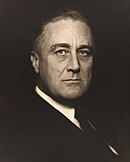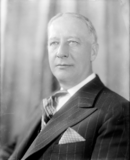| This article needs additional citations for verification. Please help improve this article by adding citations to reliable sources. Unsourced material may be challenged and removed. Find sources: "1932 Democratic Party presidential primaries" – news · newspapers · books · scholar · JSTOR (May 2023) (Learn how and when to remove this message) |
| |||||||||||||||||||||||||||||
1,154 delegates to the Democratic National Convention 770 (two-thirds) votes needed to win | |||||||||||||||||||||||||||||
|---|---|---|---|---|---|---|---|---|---|---|---|---|---|---|---|---|---|---|---|---|---|---|---|---|---|---|---|---|---|
| |||||||||||||||||||||||||||||
 First place by popular vote
First place by popular vote  First place by convention roll call Roosevelt Smith Garner Various
First place by convention roll call Roosevelt Smith Garner Various | |||||||||||||||||||||||||||||
| |||||||||||||||||||||||||||||
From March 8 to May 20, 1932, voters and members of the Democratic Party elected delegates to the 1932 Democratic National Convention for the purpose of nominating a candidate for president in the 1932 United States presidential election. New York Governor Franklin D. Roosevelt was selected as the nominee through a series of primary elections and caucuses culminating in the 1932 Democratic National Convention held from June 27 to July 2, 1932, in Chicago, Illinois.
Background
Al Smith was the unsuccessful Democratic nominee for president in 1928. After receiving the Democratic nomination, Smith was prohibited by New York law from simultaneously running for reelection in the 1928 gubernatorial election. Smith persuaded his then-ally Franklin D. Roosevelt to run in his place. Roosevelt won.
Though Smith's initial plan was to use the 1928 campaign as a springboard to the White House in 1932, he demurred following his defeat, loosening his grip on both the Democratic National Committee and Tammany Hall and instructing several inquirers, including Roosevelt, that he would not seek the White House in 1932. However, Smith began to reconsider his decision following a series of snubs by Roosevelt, his own dissatisfaction with the private sector, and the rising odds of a Democratic victory over Herbert Hoover following the 1929 stock market crash and ensuing Great Depression.
Beginning the day after his 1931 inauguration for a second term as Governor of New York, Roosevelt allowed his aides Louis Howe and James Farley to float his name as a potential candidate for president in 1932.
An early test of Roosevelt's strength came when Democratic National Committee chairman John Jakob Raskob floated a proposal to have the party endorse the repeal of Prohibition and the Smoot–Hawley Tariff Act, both positions unpopular with Roosevelt's potential base in the South and West. Endorsing the tariff would also signal a boost to Smith's bid for a second nomination for president, since Smith had already endorsed it. Defying Raskob's expectations, Roosevelt opposed the motion and gathered enough support to force Raskob to withdraw both proposals at the March 5 meeting, thereby solidifying his support in the South and West. Regional leaders like Cordell Hull began to rally behind Roosevelt's potential candidacy.
Roosevelt and his supporters spent much of 1931 cultivating support from party leaders and potential delegates in the South and West. Roosevelt secured endorsements from Hull, Pat Harrison, James F. Byrnes, and Richard Russell Jr. These conversations, along with internal polling conducted by Jesse I. Straus and the Scripps-Howard newspaper agency, convinced Roosevelt that he was a serious front-runner for the nomination.
At the January 9, 1932 national committee meeting, Roosevelt's allies successfully moved to place the 1932 convention in Chicago and elevate an ally to secretary of the party. On January 23, Roosevelt officially announced his candidacy.
In February 1932, Smith publicly commented that he “would place cause in the hands of the people and risk chances without making an active campaign for the nomination.” While this was not a clear declaration of candidacy, political observers saw this as an indication that Smith was making himself available as a “Stop Roosevelt” candidate ahead of the first primary contest, which would be held in New Hampshire.
Candidates
| Candidate | Born | Office Held | State | Delegates |
|---|---|---|---|---|
 Franklin D. Roosevelt |
January 30, 1882 (age 50) Hyde Park, New York |
44th Governor of New York (1929–1932) |
666.25 |
| Candidate | Born | Office Held | State | Delegates |
|---|---|---|---|---|
 Al Smith (Campaign) |
December 30, 1873 (age 58) Manhattan, New York |
42nd Governor of New York (1919–1920, 1923–1928) |
201.75 | |
 John Nance Garner |
November 22, 1868 (age 63) Detroit, Texas |
39th Speaker of the House of Representatives (1931–1933) |
90.25 |
Primaries and results
| Date | Contest | Delegates | Roosevelt | Lewis | Smith | Garner | Murray | Leo J. Chassee | Uncommitted | Others |
| March 8 | New Hampshire primary | 8 | 8 61.87% (15,401) |
- | - | - | - | - | - | - |
| March 15 | North Dakota primary | 9 61.91% (52,000) |
- | - | - | 1 38.10% (32,000) |
- | - | - | |
| March 23 | Georgia primary | 90.29% (51,498) | - | - | - | - | - | - | 9.71% (5,541) | |
| April 5 | Wisconsin primary | 98.57% (241,742) | - | 1.43% (W) (3,502) | - | - | - | - | - | |
| April 12 | Nebraska primary | 62.99% (91,393) | - | - | 18.86% (27,359) | 17.38% (25,214) | - | - | 0.77% (1,121) | |
| April 13 | Illinois primary | 58 | 0.18% (W) (1,084) | 58 99.76% (590,130) |
0.05% (W) (266) | 0.01% (W) (35) | - | - | - | 0.01% (W) (37) |
| April 26 | Massachusetts primary | 26.89% (56,454) | - | 73.11% (153,465) | - | - | - | - | - | |
| Pennsylvania primary | 56.65% (133,002) | - | 43.11% (101,227) | - | - | - | - | - | ||
| May 3 | Alabama primary | 100.00% (134,781) | - | - | - | - | - | - | - | |
| California primary | 32.47% (175,008) | - | 26.26% (141,517) | 41.27% (222,385) | - | - | - | - | ||
| South Dakota primary | 100.00% (35,370) | - | - | - | - | - | - | - | ||
| May 10 | Ohio primary | 1.71% (W) (1,999) | - | 0.82% (W) (951) | 0.06% (W) (72) | 96.45% (112,512) | - | - | 0.96% (W) (1,123) | |
| West Virginia primary | 90.32% (219,671) | - | - | - | 8.15% (19,826) | 1.53% (3,727) | - | - | ||
| May 17 | New Jersey primary | 36.27% (W) (3,219) | - | 58.97% (W) (5,234) | 1.56% (W) (138) | - | - | - | 3.20% (W) (285) | |
| May 20 | Oregon primary | 78.62% (48,554) | - | - | - | 19.42% (11,993) | - | - | 1.97% (1,214) | |
| June 7 | Florida primary | 87.71% (203,372) | - | - | - | 10.72% (24,847) | 1.57% (3,645) | - | - |
- Favorite sons received the support of Virginia (Harry F. Byrd), Oklahoma (William H. Murray), Missouri (James A. Reed), Ohio, and Maryland (Albert Ritchie). The Ohio primary was won by Murray.
- Favorite son Gus H. Howard.
| Legend: | 1st place(popular vote) | 2nd place(popular vote) | 3rd place(popular vote) | Candidate has Withdrawnor Ceased Campaigning | (W) - Votes are Write-In |
|---|
Delegates not selected in primaries
Many delegations were not selected in public statewide primaries. The following table shows delegates awarded at a state level by convention, committees, and other means that did not involve votes by a public electorate.
| Delegates not awarded via primaries | ||||||||||
| Other delegate allocation | ||||||||||
| Date | Contest | Delegates | Roosevelt | Lewis | Smith | Garner | Murray | Leo J. Chassee | Uncommitted | Others |
| January 23 | Territory of Alaska convention | 6 | 6 | - | - | - | - | - | - | - |
| January | Washington county caucuses | 16 | 16 | - | - | - | - | - | - | - |
| February | Oklahoma convention | 22 | - | - | - | - | 22 | - | - | - |
| March 12 | Minnesota convention | 24 | 24 | - | - | - | - | - | - | - |
| March 29 | Iowa convention | 26 | ||||||||
| Maine convention | 12 | |||||||||
| March | Missouri convention | 36 | ||||||||
| March | Maryland convention | |||||||||
| March | Arkansas convention | 18 | ||||||||
See also
Notes
- Roosevelt did not win all 16 delegates at the county caucuses, but county delegates to the state convention were instructed to vote for Roosevelt delegates. When the state convention was eventually held, Roosevelt swept the delegates.
- Smith supporters stormed out of the convention and held a rump convention nominating their own slate of 24 delegates to contest credentials at the Chicago convention.
- Favorite son James A. Reed, though party boss Tom Pendergast had privately pledged support to Roosevelt as necessary.
- Maryland's delegates were pledged to favorite son Albert Ritchie.
References
- Kalb, Deborah (2016-02-19). Guide to U.S. Elections - Google Books. CQ Press. ISBN 9781483380353. Retrieved 2016-02-19.
- ^ Caro, Robert (1974). The Power Broker: Robert Moses and the Fall of New York. New York: Knopf. ISBN 978-0-394-48076-3. OCLC 834874.
- Smith 2007, p. 249.
- Smith 2007, p. 252.
- Smith 2007, pp. 253–54.
- Smith 2007, p. 256.
- Smith 2007, pp. 254–58.
- Smith 2007, p. 258.
- ^ Scranton, Philip (March 15, 2012). "The Strange Start of FDR's 1932 Campaign: Echoes". www.bloomberg.com. Bloomberg News. Retrieved May 16, 2018.
- ^ Smith 2007, p. 259.
- ^ Smith 2007, p. 260.
- ^ Smith 2007, p. 261.
Bibliography
- Smith, Jean Edward (2007). FDR (1st ed.). New York: Random House. ISBN 978-1-4000-6121-1.
- Caro, Robert (1974). The Power Broker: Robert Moses and the Fall of New York. New York: Knopf. ISBN 978-0-394-48076-3. OCLC 834874.
| United States presidential primaries and caucuses | |||||||||||||||||||
|---|---|---|---|---|---|---|---|---|---|---|---|---|---|---|---|---|---|---|---|
| Election timelines | |||||||||||||||||||
| National opinion polling | |||||||||||||||||||
| State opinion polling | |||||||||||||||||||
| Fundraising | |||||||||||||||||||
| Debates and forums | |||||||||||||||||||
| Straw polls | |||||||||||||||||||
| Major events | |||||||||||||||||||
| Caucuses and primaries |
| ||||||||||||||||||
| Results breakdown | |||||||||||||||||||
| National conventions |
| ||||||||||||||||||
| Reforms | |||||||||||||||||||
| (← 1928) 1932 United States presidential election (→ 1936) | |||||||||||||
|---|---|---|---|---|---|---|---|---|---|---|---|---|---|
| Democratic Party (Primaries · Convention) |
| ||||||||||||
| Republican Party (Primaries · Convention) |
| ||||||||||||
| |||||||||||||


